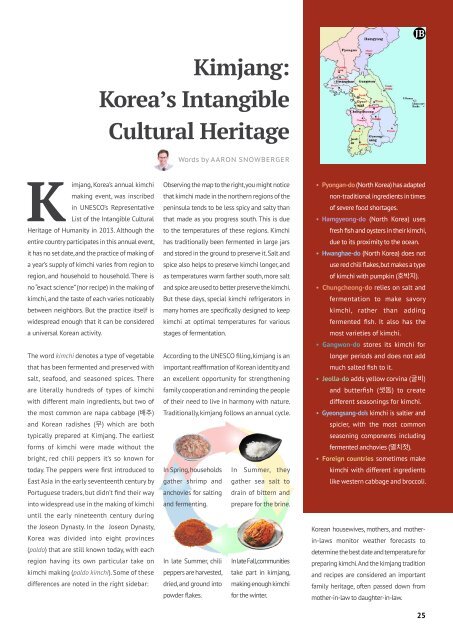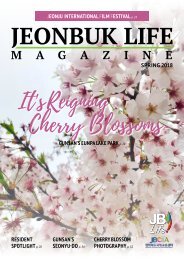You also want an ePaper? Increase the reach of your titles
YUMPU automatically turns print PDFs into web optimized ePapers that Google loves.
Kimjang:<br />
Korea’s Intangible<br />
Cultural Heritage<br />
Words by Aaron Snowberger<br />
Kimjang, Korea’s annual kimchi<br />
making event, was inscribed<br />
in UNESCO’s Representative<br />
List of the Intangible Cultural<br />
Heritage of Humanity in 2013. Although the<br />
entire country participates in this annual event,<br />
it has no set date, and the practice of making of<br />
a year’s supply of kimchi varies from region to<br />
region, and household to household. There is<br />
no “exact science” (nor recipe) in the making of<br />
kimchi, and the taste of each varies noticeably<br />
between neighbors. But the practice itself is<br />
widespread enough that it can be considered<br />
a universal Korean activity.<br />
The word kimchi denotes a type of vegetable<br />
that has been fermented and preserved with<br />
salt, seafood, and seasoned spices. There<br />
are literally hundreds of types of kimchi<br />
with different main ingredients, but two of<br />
the most common are napa cabbage (배추)<br />
and Korean radishes (무) which are both<br />
typically prepared at Kimjang. The earliest<br />
forms of kimchi were made without the<br />
bright, red chili peppers it’s so known for<br />
today. The peppers were first introduced to<br />
East Asia in the early seventeenth century by<br />
Portuguese traders, but didn’t find their way<br />
into widespread use in the making of kimchi<br />
until the early nineteenth century during<br />
the Joseon Dynasty. In the Joseon Dynasty,<br />
Korea was divided into eight provinces<br />
(paldo) that are still known today, with each<br />
region having its own particular take on<br />
kimchi making (paldo kimchi). Some of these<br />
differences are noted in the right sidebar:<br />
Observing the map to the right, you might notice<br />
that kimchi made in the northern regions of the<br />
peninsula tends to be less spicy and salty than<br />
that made as you progress south. This is due<br />
to the temperatures of these regions. Kimchi<br />
has traditionally been fermented in large jars<br />
and stored in the ground to preserve it. Salt and<br />
spice also helps to preserve kimchi longer, and<br />
as temperatures warm farther south, more salt<br />
and spice are used to better preserve the kimchi.<br />
But these days, special kimchi refrigerators in<br />
many homes are specifically designed to keep<br />
kimchi at optimal temperatures for various<br />
stages of fermentation.<br />
According to the UNESCO filing, kimjang is an<br />
important reaffirmation of Korean identity and<br />
an excellent opportunity for strengthening<br />
family cooperation and reminding the people<br />
of their need to live in harmony with nature.<br />
Traditionally, kimjang follows an annual cycle.<br />
In Spring, households In Summer, they<br />
gather shrimp and gather sea salt to<br />
anchovies for salting drain of bittern and<br />
and fermenting. prepare for the brine.<br />
In late Summer, chili In late Fall, communities<br />
peppers are harvested, take part in kimjang,<br />
dried, and ground into making enough kimchi<br />
powder flakes. for the winter.<br />
• Pyongan-do (North Korea) has adapted<br />
non-traditional ingredients in times<br />
of severe food shortages.<br />
• Hamgyeong-do (North Korea) uses<br />
fresh fish and oysters in their kimchi,<br />
due to its proximity to the ocean.<br />
• Hwanghae-do (North Korea) does not<br />
use red chili flakes, but makes a type<br />
of kimchi with pumpkin (호박지).<br />
• Chungcheong-do relies on salt and<br />
fermentation to make savory<br />
kimchi, rather than adding<br />
fermented fish. It also has the<br />
most varieties of kimchi.<br />
• Gangwon-do stores its kimchi for<br />
longer periods and does not add<br />
much salted fish to it.<br />
• Jeolla-do adds yellow corvina (굴비)<br />
and butterfish (샛돔) to create<br />
different seasonings for kimchi.<br />
• Gyeongsang-do’s kimchi is saltier and<br />
spicier, with the most common<br />
seasoning components including<br />
fermented anchovies (멸치젓).<br />
• Foreign countries sometimes make<br />
kimchi with different ingredients<br />
like western cabbage and broccoli.<br />
Korean housewives, mothers, and motherin-laws<br />
monitor weather forecasts to<br />
determine the best date and temperature for<br />
preparing kimchi. And the kimjang tradition<br />
and recipes are considered an important<br />
family heritage, often passed down from<br />
mother-in-law to daughter-in-law.<br />
25















